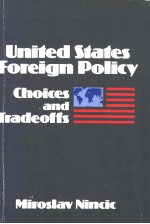

UNITED STATES FOREIGN POLICY CHOICES AND TRADEOFFSPDF电子书下载
- 电子书积分:14 积分如何计算积分?
- 作 者:
- 出 版 社:A DIVISION OF CONGRESSIONAL QUARTERLY INC
- 出版年份:2222
- ISBN:0871874490
- 页数:407 页
Section One. The Challenges and the Setting 1
1. The Foreign Policy Challenge 3
The Objectives of Foreign Policy 4
The Instruments of Foreign Policy 10
Foreign Policy and the Political System 20
The Three Dilemmas of Foreign Policy 23
2. The International Environment 27
The Second World: The Politics of Hostility 28
The First World: Friendship and Its Limits 40
The Third World: Politics and Equity 45
Section Two. The Domestic Politics of Foreign Policy 55
3. Direction and Effects of Public Opinion 57
Political Animals and Prehistoric Monsters 57
Public Opinion on Foreign Policy Issues 61
The Public's Impact on Foreign Policy 69
4. The Role of Congress 79
Constitutional Provisions 80
The Era of Acquiescence 82
Congressional Resurgence 90
Future Directions 98
Appendix: Milestones in Congressional Foreign Policy Activism 102
5. The Presidency and the Bureaucracy 105
The Chief Executive 106
The Major Institutions 108
Foreign Policy Making in the Executive Branch 121
6. Interest Groups 131
How Interest Groups Operate 133
Business Groups 135
The Farm Lobbies 139
Organized Labor 140
Ethnic Lobbies 142
Lobbies for Foreign Governments 144
"Public Interest" Groups 145
Conclusions 147
Section Three. Friends and Adversaries 151
7. Sources of Conflict and Cooperation 153
Hostility: Initiating Causes 154
Hostility: Reinforcing Causes 161
The Bases of Friendship 166
Interaction and Reciprocity 171
8. The Causes of U.S.-Soviet Rivalry 177
Initiating Causes 179
Reinforcing Causes 194
The Outlook 199
Appendix: Milestones in U.S.-Soviet Relations 201
9. Friendship and Friction in the Western Alliance 205
The Foundation of Cooperation 205
The Sources of Tension 210
The Alliance in Perspective 222
10. Interventions in the Third World 227
Recent Instances of Intervention 227
The Uses and Costs of Military Force 233
The Dynamics of Escalating Involvement 238
Conclusions 248
Appendix: Major U.S. Military Interventions since World War II 249
Section Four. War and Peace 253
11. Nuclear War: Consequences and Causes 255
Physical Effects of Nuclear Weapons 256
Effects on the Society and Economy 258
Nuclear War by Accident 262
The Preemptive Strike 266
Escalation from a Conventional War 270
Reducing the Risk of Nuclear War 276
Conclusions 280
12. Weapons and Doctrines 283
Trends in Weaponry 283
The Strategic Balance 286
Strategic Doctrine 288
The Search for Strategic Defense 303
13. Controlling the Arms Race 309
The Arms Control Record 310
The Dynamics of the Arms Race 317
The Conditions for Arms Control 323
Appendix: Principal Arms Control Agreements Signed by the United States 328
Section Five. National Prosperity and International Welfare 331
14. Economic Relations in the Developed World 333
The Advantages of Free Trade 334
The Economic Order after World War II 336
The Emergence of Neomercantilism 339
Neomercantilism and Politics 342
Dealing with Neomercantilism 346
15. Problems of Third World Development 353
The Postwar Years 355
"All Good Things Go Together" 357
Assertiveness in the Third World 359
Dependency Theory 361
The NIEO 365
U.S. Economic Interests in the Third World 368
Section Six. Conclusions 373
16. Looking Back and Looking Ahead 375
Foreign Policy and Democracy 375
Security, Peace, and Military Force 379
National and International Prosperity 386
The Issue of Human Rights 389
Index 395
- 《“中国印”的世界 骆芃芃篆刻书法艺术展作品集 the collection of exhibition of seal engraving and calligraphic works》骆芃芃著 2012
- 《Foundations of criminal law》[edited] by Leo Katz 1999
- 《DETECTION AND SPECTROMETRY OF FAINT LIGHT》JOHN MEABURN
- 《冷战后美日同盟转型研究=STUDY ON TRANSFORMATION OF THE US-JAPAN ALLIANCE AFTER THE COLD WAR》衣昭杰著 2020
- 《现代艺术的源代码=THE SHORT STORY OF MODERN ART》(英)苏西·霍奇著 2020
- 《唐帝国的香气=A BRIEF HISTORY OF THE TANG DYNASTY》殷靖著 2020
- 《幸福感符号学 社会文化修辞=SEMIOTICS OF HAPPINESS RHETORIC BEGINNING OF A PUBLIC PROBLEM》(英)阿什利·弗劳利(Ashley Frawley)著 2019
- 《细节中的新中国史=THE HISTORY OF THE PEOPLES REPUBLIC OF CHINA IN DETAILS》张神根 2020
- 《汉译文学性概论=RESEARCH ON LITERARINESS OF FOREIGN LITERATURE TRANSLATION INTO CHINESE》侯影著 2019
- 《燃料电池汽车动力系统分布式测试数据传输研究=DATA TRANSMISSION ANALYSIS OF DISTRIBUTED TEST PLATFORM FOR FUEL CELL》牛文旭著 2020
